The 1930s was a transformative decade for women’s hairstyles, marking a dramatic shift from the bold, boyish cuts of the roaring twenties to softer, more feminine waves and curls that defined Hollywood’s golden age.
When you think about 27 Iconic 1930s Hairstyles for Women That Stay Forever Stylish, you’re exploring an era where glamour met practicality, and every woman could channel her inner silver screen starlet with the right set of pin curls or finger waves.
This article takes you through the most captivating hairstyles that graced the heads of style icons like Jean Harlow, Greta Garbo, and Marlene Dietrich, showing you how these timeless looks continue to inspire modern fashion and red carpet events nearly a century later.
You’ll discover the techniques behind marcel waves, victory rolls, and the sophisticated updos that made the 1930s one of the most elegant periods in beauty history, complete with styling tips and ways to adapt these vintage looks for today’s wardrobe.
Whether you’re planning a themed event, seeking inspiration for a special occasion, or simply fascinated by the enduring appeal of old Hollywood glamour, this comprehensive guide reveals why these 27 hairstyles have never truly gone out of style.
Contents
- 1 1. Finger Waves
- 2 2. Marcel Waves
- 3 3. Pin Curls
- 4 4. The Jean Harlow Platinum Blonde
- 5 5. The Greta Garbo Bob
- 6 6. Victory Rolls
- 7 7. The Pageboy
- 8 8. Curled Under Bob
- 9 9. Side-Swept Waves
- 10 10. The Halo Braid
- 11 11. Pompadour Front
- 12 12. Low Chignon
- 13 13. Barrel Curls
- 14 14. The Marlene Dietrich Wave
- 15 15. Braided Updo
- 16 16. Soft Feathered Ends
- 17 17. Sculptured Crown
- 18 18. The Joan Crawford Wave
- 19 19. Rolled Sides
- 20 20. The Shirley Temple Curl
- 21 21. Center Part with Waves
- 22 22. Faux Bob with Pinned Hair
- 23 23. Asymmetrical Wave Pattern
- 24 24. The Coronet Braid
- 25 25. Deep Waves with Height
- 26 26. Soft Romantic Curls
- 27 27. The Working Woman’s Wave
- 28 Styling Tips for Modern Adaptation
- 29 Historical Context and Cultural Impact
- 30 Tools and Products of the Era
- 31 Face Shape Considerations
- 32 Celebrity Style Icons
- 33 Adaptation for Different Hair Types
- 34 Maintenance and Longevity
- 35 Common Styling Mistakes to Avoid
- 36 Photography and Presentation
- 37 Conclusion
1. Finger Waves

Finger waves were the signature hairstyle of the 1930s, characterized by S-shaped curves molded into wet hair using fingers, combs, and setting lotion.
This sculptural style became synonymous with sophistication and required considerable skill to execute properly, making it a favorite among salon professionals and style-conscious women of the era.
Key Characteristics:
- Created shallow, uniform waves that hugged the scalp closely
- Required strong-hold gel or setting lotion to maintain the defined pattern
- Worked best on short to medium-length hair
- Could be worn as an all-over style or combined with pin curls at the ends
- Took 30-45 minutes to set and needed to dry completely before brushing
Modern Styling Tips:
- Use a modern wave setting gel or mousse on damp hair for easier manipulation
- Work in small sections, creating each wave with a fine-tooth comb and clips
- Allow hair to air dry or sit under a hooded dryer for lasting results
- Pair with bold red lipstick and defined eyebrows for authentic 1930s glamour
- Consider this style for weddings, gatsby-themed parties, or vintage photo shoots
2. Marcel Waves
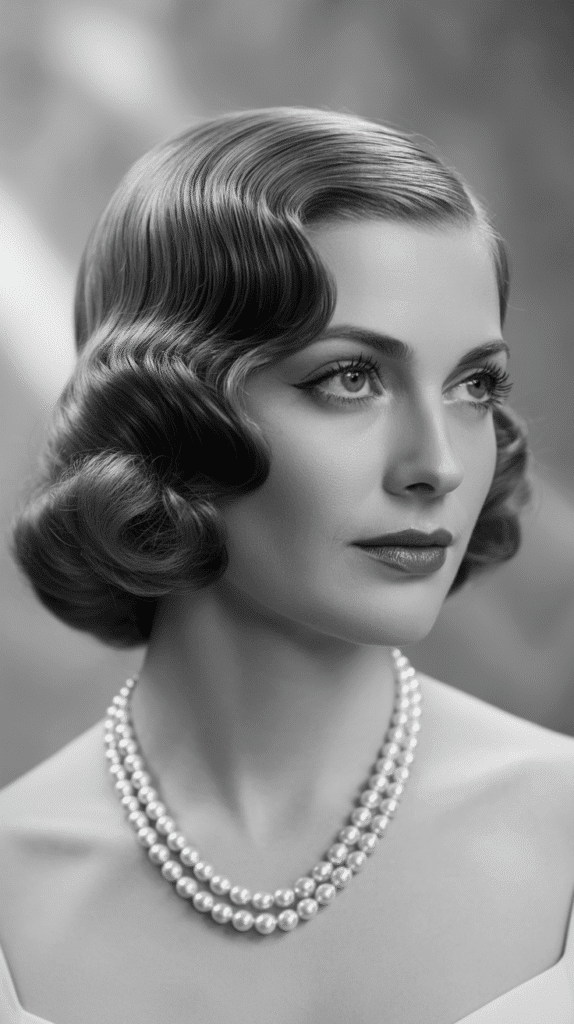
Marcel waves, named after French hairstylist Marcel Grateau who invented the technique in the 1870s, reached their peak popularity during the 1930s with deeper, more dramatic curves than finger waves.
These waves were created using heated marcel irons, producing a glossy, sculptural effect that photographed beautifully and lasted for days.
Technique Details:
- Used specialized heated curling irons with a cylindrical barrel and groove
- Created deeper, wider waves with more volume than finger waves
- Required precise temperature control to avoid heat damage
- Produced a shinier, more polished finish
- Could be styled on both wet and dry hair depending on the desired effect
Distinguishing Features:
- Waves appeared rounder and more three-dimensional
- Each wave section was typically wider (2-3 inches) than finger waves
- The style offered more height and body at the crown
- Hair reflected light beautifully due to the heat-sealing technique
- Often combined with side parts and dramatic swoops across the forehead
3. Pin Curls
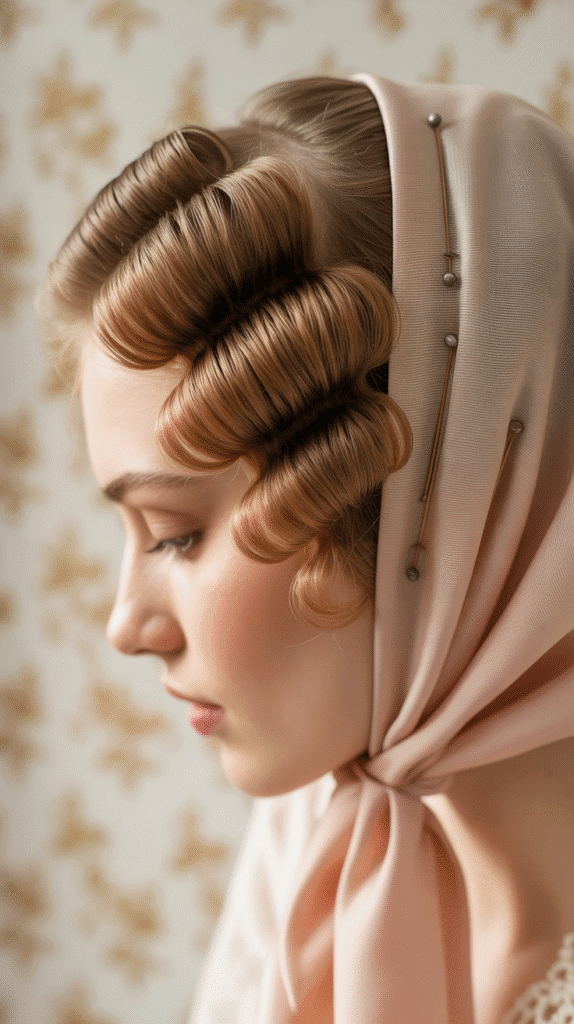
Pin curls were the foundation of 1930s hairstyling, serving as the building blocks for countless elegant looks and providing women with an accessible way to achieve Hollywood glamour at home.
These small, flat curls were secured against the scalp with bobby pins and could be arranged in various patterns to create specific wave formations or volume.
Creating Pin Curls:
- Sectioned damp hair into small squares or rectangles
- Wrapped each section around fingers to form flat, circular curls
- Pinned the curls flat against the scalp in strategic directions
- Left to dry completely (usually overnight) before brushing out
- Could be arranged in rows, brick patterns, or circular formations
Pattern Variations:
- Forward curls created waves that moved toward the face
- Reverse curls produced waves that moved away from the face
- Alternating patterns generated the signature S-shaped wave pattern
- Clockwise and counterclockwise directions affected final wave placement
- Skip-wave patterns created a more relaxed, casual wave effect
4. The Jean Harlow Platinum Blonde
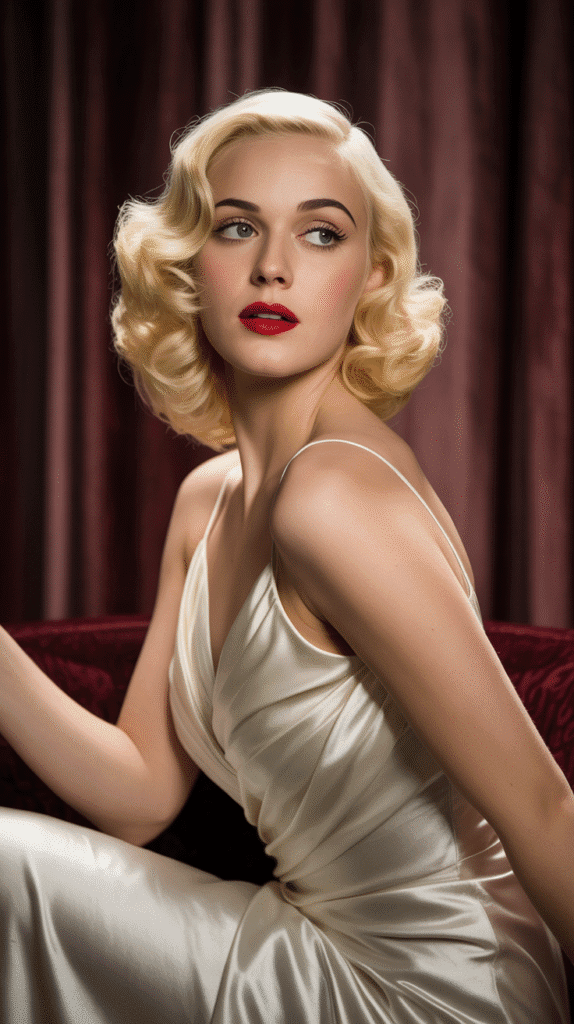
Jean Harlow revolutionized 1930s beauty standards with her striking platinum blonde hair, becoming the original “blonde bombshell” and inspiring countless women to lighten their locks.
Her signature look combined ultra-light blonde hair with soft waves, dark eyebrows, and sultry makeup that created a shocking contrast for the era.
Achieving the Platinum Look:
- Required multiple bleaching sessions to reach pure white-blonde
- Maintenance involved weekly toning treatments to prevent brassiness
- Harlow’s hairstylist used a mixture of ammonia, Clorox, and Lux flakes (not recommended today)
- Modern methods use professional-grade lighteners and purple toners
- Deep conditioning treatments were essential to maintain hair health
Styling Components:
- Soft, shoulder-length waves with plenty of movement
- Deep side part or center part depending on face shape
- Ends curled under or flipped slightly for polish
- High shine achieved through pomades and hair oils
- Contrast maintained with dark, defined eyebrows
Historical Context:
According to beauty historians at the Smithsonian National Museum of American History, Jean Harlow’s platinum blonde hair caused a nationwide sensation and increased peroxide sales by 35% in the early 1930s, despite the harsh chemicals damaging her hair severely.
5. The Greta Garbo Bob
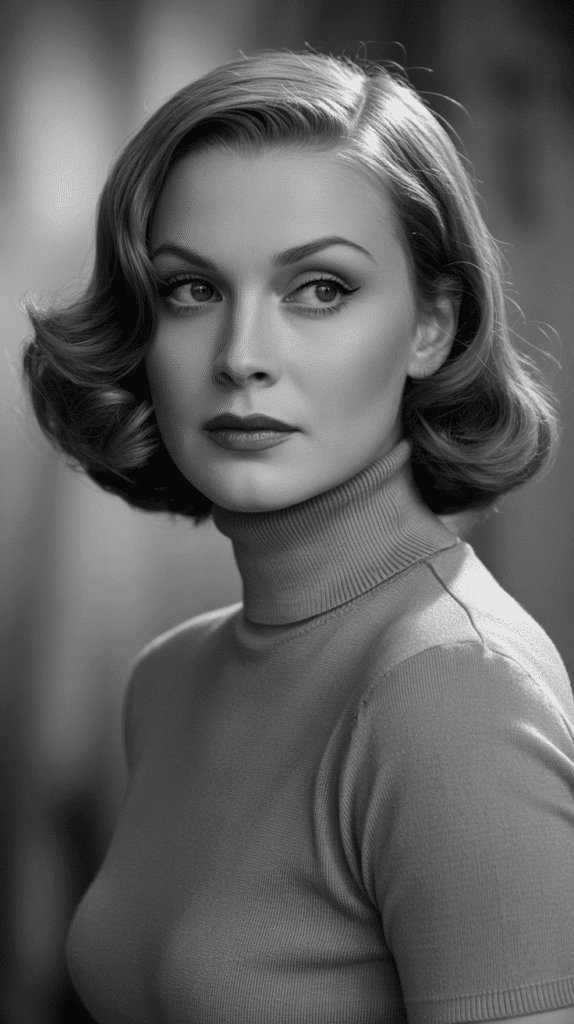
Greta Garbo’s sophisticated bob became an icon of understated elegance in the 1930s, offering a more refined alternative to the shorter flapper cuts of the previous decade.
Her hairstyle emphasized sleek lines, subtle waves, and a polished finish that complemented her enigmatic persona.
Style Characteristics:
- Length typically reached between chin and shoulder
- Smooth, sleek surface with controlled waves
- Often featured a deep side part
- Ends turned under for a polished, finished look
- Minimal volume at the crown for a streamlined silhouette
Garbo’s Styling Approach:
- Hair was kept impeccably groomed and shiny
- Waves were subtle rather than dramatic
- The style could be tucked behind one ear for asymmetry
- Often paired with berets, cloche hats, or wide-brimmed headwear
- Color remained natural browns and chestnuts rather than platinum
6. Victory Rolls
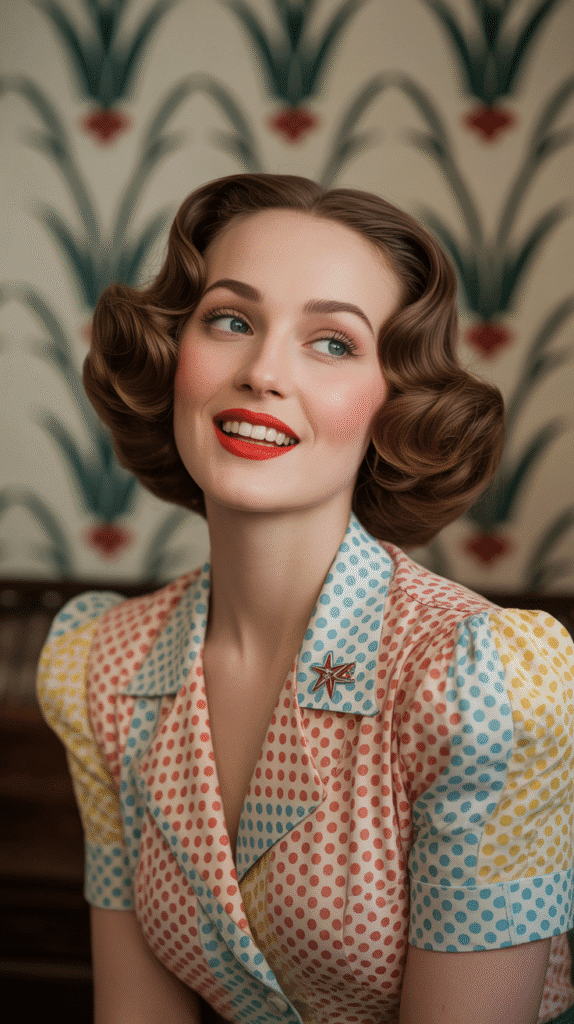
Victory rolls emerged in the late 1930s and became increasingly popular into the 1940s, characterized by large, rolled sections of hair pinned prominently at the front of the head.
This distinctive style represented both feminine beauty and the growing strength of women as the decade progressed toward wartime.
Construction Method:
- Front sections of hair were backcombed for volume
- Hair was rolled upward and inward toward the scalp
- Each roll was secured with bobby pins or hairpins
- Could be created as a single central roll or symmetrical side rolls
- Required medium to long hair for proper fullness
Style Variations:
- Single victory roll placed at the crown or forehead
- Double victory rolls positioned symmetrically on each side
- Asymmetrical placement with one larger roll on one side
- Combined with curls, waves, or updos in the back
- Height varied from subtle bumps to dramatic, towering rolls
7. The Pageboy
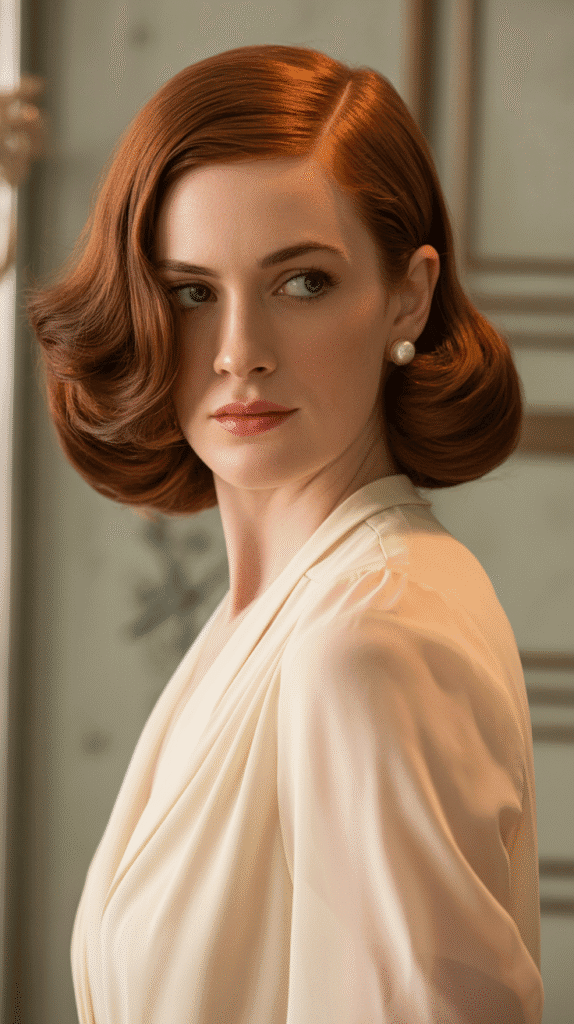
The pageboy cut gained tremendous popularity in the late 1930s, offering women a practical yet elegant hairstyle that required less maintenance than intricate wave patterns.
This style featured hair of uniform length, typically between chin and shoulder, with ends smoothly rolled under in a continuous curve.
Defining Features:
- Blunt cut at uniform length all around the head
- Ends curled under in a smooth, continuous roll
- Could incorporate bangs or a side-swept fringe
- Natural volume without excessive teasing or backcombing
- Clean, geometric lines that photographed well
Achieving the Perfect Pageboy:
- Hair was set on large rollers positioned underneath
- Ends were rolled tightly to create the signature curve
- The crown area was kept relatively flat and smooth
- A center or slight side part was most common
- Regular trims every 4-6 weeks maintained the blunt line
Versatility:
The pageboy transitioned easily from day to evening by adding accessories like jeweled clips, headbands, or fresh flowers, making it ideal for the economically conscious woman of the Depression era who needed one style for multiple occasions.
8. Curled Under Bob
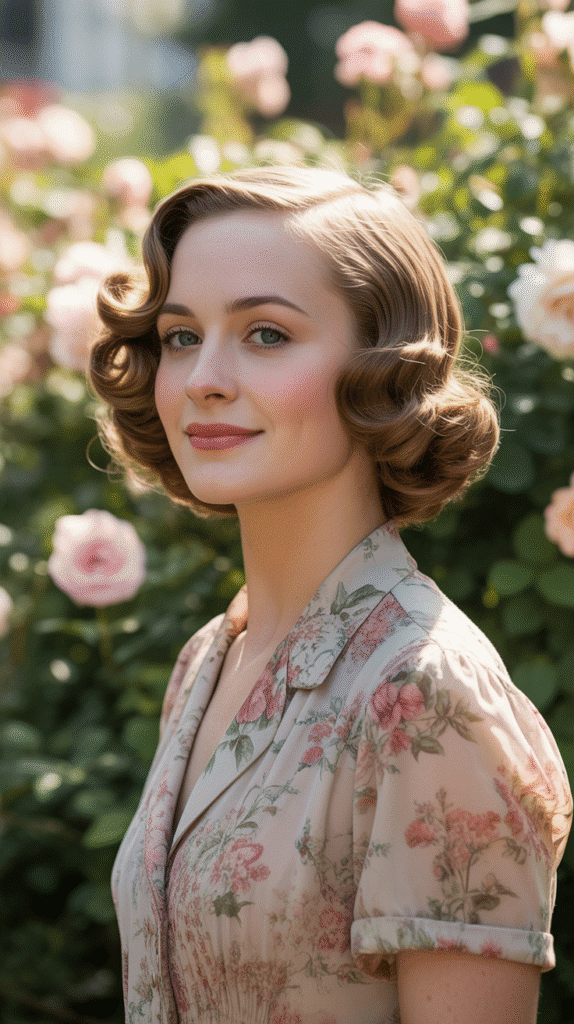
The curled under bob refined the bob haircut of the 1920s by adding sophisticated styling techniques that softened the overall appearance.
This style featured hair cut to approximately chin length with the ends curled neatly under using pin curls or heated curling irons.
Technical Approach:
- Hair was typically cut to hit at jawline or just below
- Ends were set in pin curls directed downward and under
- The result was a smooth, rounded silhouette
- Could incorporate subtle waves through the lengths
- Front sections might feature finger waves for added detail
Styling Considerations:
- Required nightly setting to maintain the curled-under shape
- Bobby pins or setting clips held curls in place while drying
- Light pomade added shine and smoothness
- The style worked well with various face shapes
- Could be customized with different parting directions
9. Side-Swept Waves
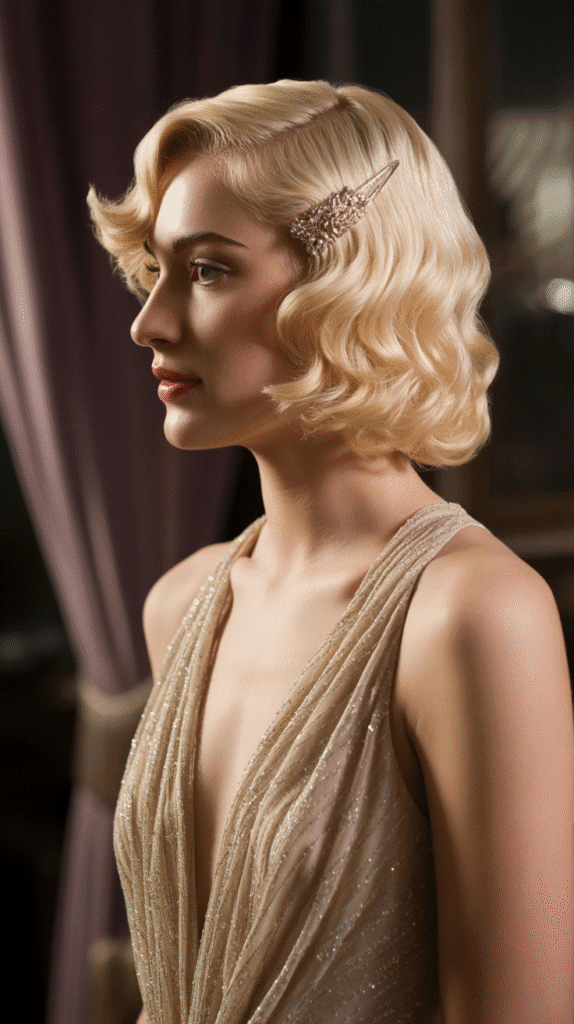
Side-swept waves became a signature look of 1930s glamour, creating asymmetry and drama by directing all wave patterns to one side of the head.
This style emphasized femininity and sophistication while allowing women to showcase dramatic profile angles.
Creating Side-Swept Drama:
- Deep side part placed 2-3 inches from the center
- Hair on the heavier side featured cascading waves
- The smaller side was often pinned smoothly against the head
- Waves were directed diagonally toward one shoulder
- Bobby pins hidden beneath waves secured the style
Design Elements:
- The heavy side created visual interest and volume
- Waves could be tight and controlled or soft and romantic
- Often revealed one ear completely while covering the other
- Worked beautifully with both short and medium-length hair
- Enhanced by decorative hair clips or fresh flowers on the pinned side
10. The Halo Braid
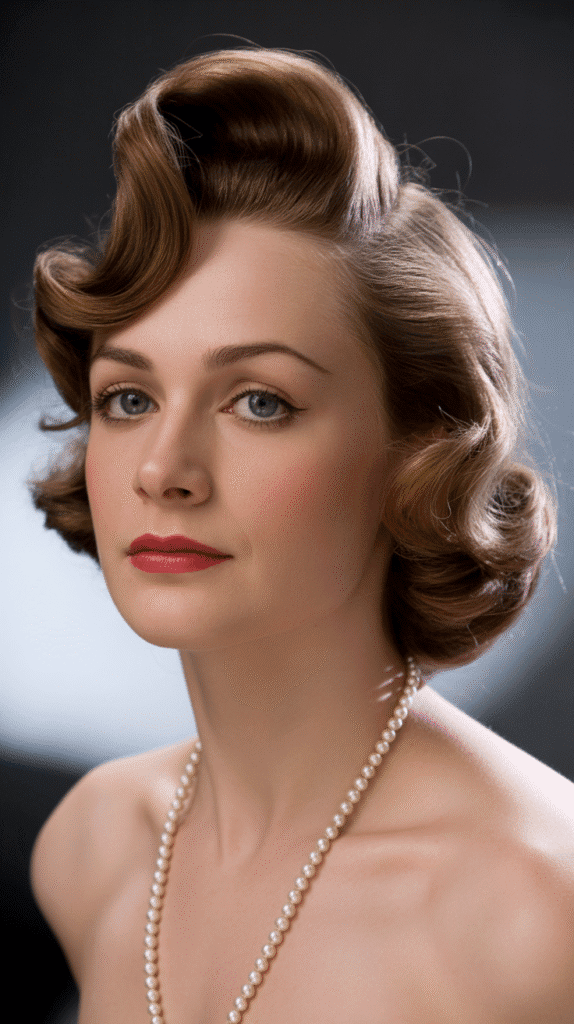
The halo braid offered 1930s women an elegant updo option that kept hair completely off the face and neck while maintaining the era’s emphasis on soft, romantic styling.
This braided crown circled the head like a coronet, creating a regal, sophisticated appearance perfect for formal occasions.
Construction Technique:
- Hair was brushed smooth and divided into sections
- Braids were created along each side of the head
- Braids were pinned across the crown to form a continuous circle
- Loose ends were tucked underneath and secured invisibly
- Sometimes incorporated ribbon or decorative pins
Variations:
- Single thick braid wrapped around the head
- Multiple thinner braids woven together
- French braiding technique starting at the nape
- Combined with curls left loose at the nape
- Adorned with fresh flowers for wedding or garden party events
11. Pompadour Front
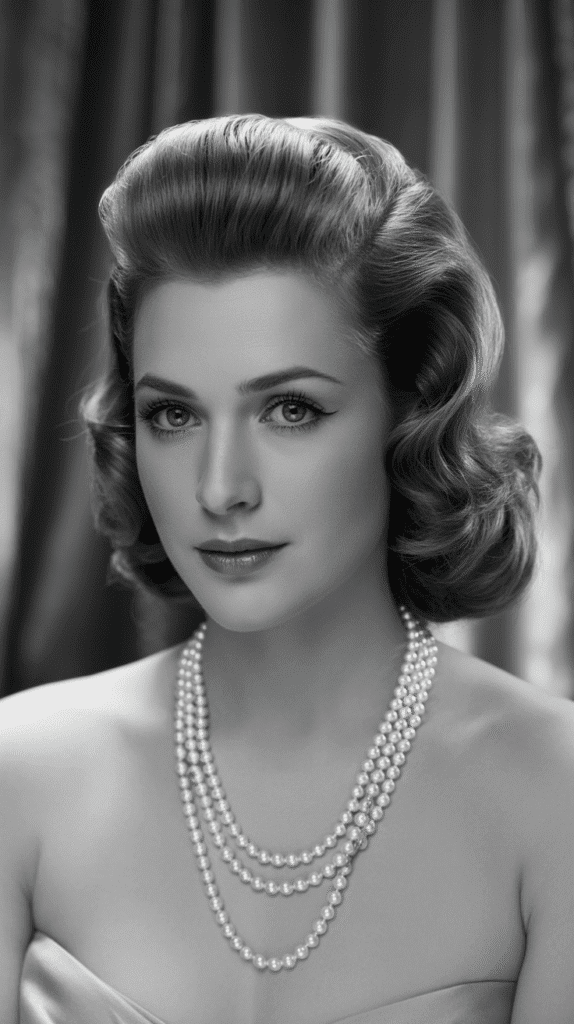
The pompadour front featured dramatically swept-back hair at the forehead, creating height and volume that balanced the softer waves typically worn through the rest of the hair.
This style element added sophistication and could be incorporated into various hairstyles throughout the 1930s.
Creating the Pompadour:
- Front section was backcombed extensively for height
- Hair was smoothly brushed over the teased base
- The section was rolled back and pinned at the crown
- Side sections were incorporated for a seamless look
- Strong-hold products maintained the lifted shape
Styling Impact:
- Added 2-4 inches of height at the hairline
- Elongated the face visually
- Created a frame for the face
- Could be combined with victory rolls, waves, or updos
- Required daily setting and maintenance
12. Low Chignon
The low chignon represented refined elegance in 1930s hairstyling, gathering hair at the nape of the neck into a smooth, twisted or rolled bun that conveyed maturity and sophistication.
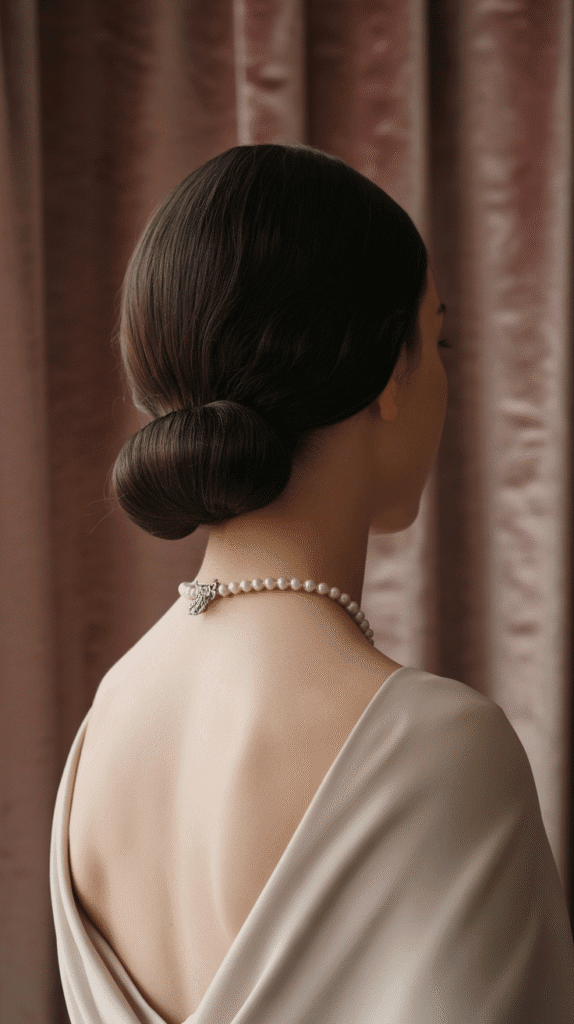
This style was particularly popular for daytime activities, professional settings, and older women who preferred more conservative looks.
Assembly Method:
- Hair was brushed smoothly back from the face
- All hair was gathered at the nape or just above
- The ponytail was twisted or rolled into a compact shape
- Bobby pins and hairpins secured the chignon from multiple angles
- Flyaways were smoothed with pomade or setting lotion
Style Characteristics:
- Positioned low on the head for a demure appearance
- Could be loose and romantic or tight and severe
- Often combined with finger waves or pin curls at the front
- Showcased the neck and earrings beautifully
- Required minimal hair accessories for everyday wear
13. Barrel Curls
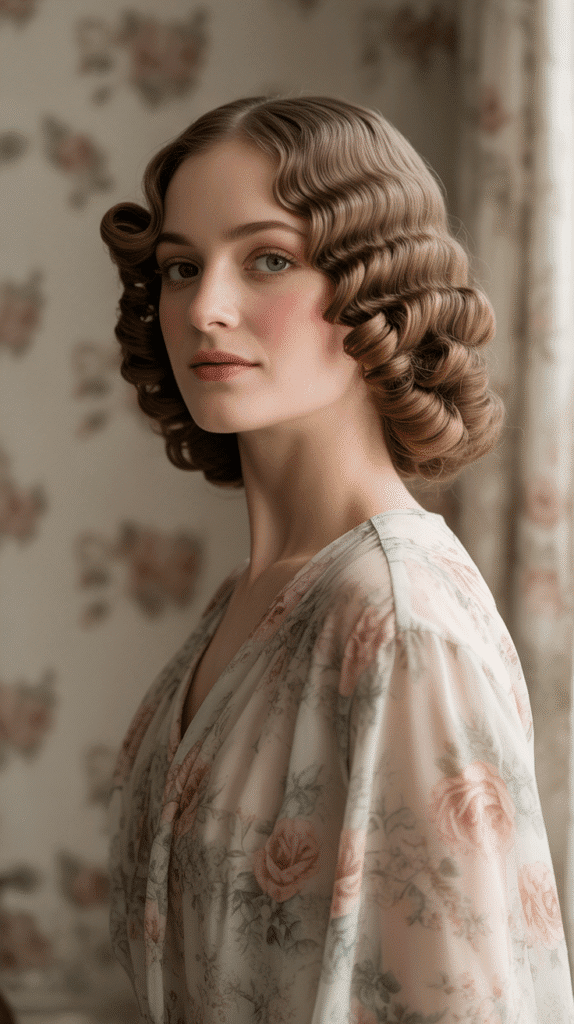
Barrel curls, also called tube curls or roll curls, created uniform, cylindrical curls that hung vertically and provided controlled, structured movement to 1930s hairstyles.
These curls differed from pin curls by hanging freely rather than being pinned flat against the head.
Creating Barrel Curls:
- Hair sections were wrapped around curling rods or rags
- Curls were formed vertically from roots to ends
- Each curl maintained a hollow, tube-like center
- Curls were left to dry completely before removal
- Resulted in springy, uniform ringlets
Styling Applications:
- Used primarily on the sides and back of the head
- Could be brushed out for softer waves or left defined
- Combined with finger waves at the crown
- Created romantic, feminine styling
- Often seen in longer hair lengths
14. The Marlene Dietrich Wave
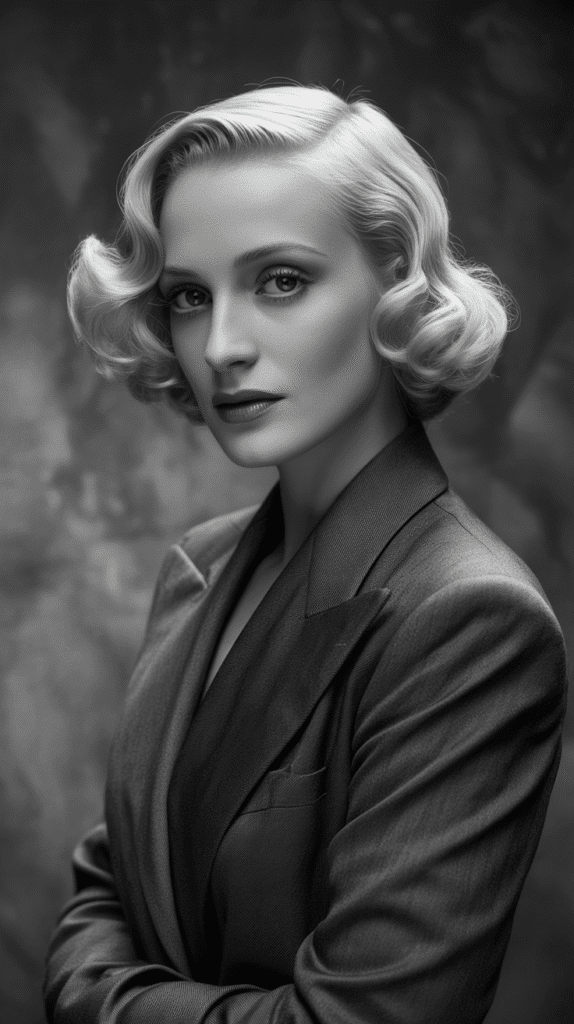
Marlene Dietrich’s signature hairstyle combined sleek sophistication with subtle sensuality, featuring smooth, controlled waves that fell gracefully to one side and perfectly complemented her androgynous fashion choices.
Her look represented the height of 1930s continental elegance.
Signature Elements:
- Extremely smooth, glossy surface
- Gentle, elongated waves rather than tight curls
- Typically swept to one side dramatically
- Emphasized clean lines and geometric precision
- Often wore hair color in natural blonde to light brown tones
Dietrich’s Styling Philosophy:
- Waves were never overly fussy or elaborate
- The style remained consistent throughout the decade
- Hair was kept impeccably maintained and conditioned
- Lighting was considered when styling for photographs
- The look balanced masculinity and femininity perfectly
Cultural Impact:
The Fashion Institute of Technology notes that Marlene Dietrich’s hairstyle influenced international fashion because it transcended traditional feminine styling while maintaining elegance, paving the way for more versatile women’s fashion in subsequent decades.
15. Braided Updo
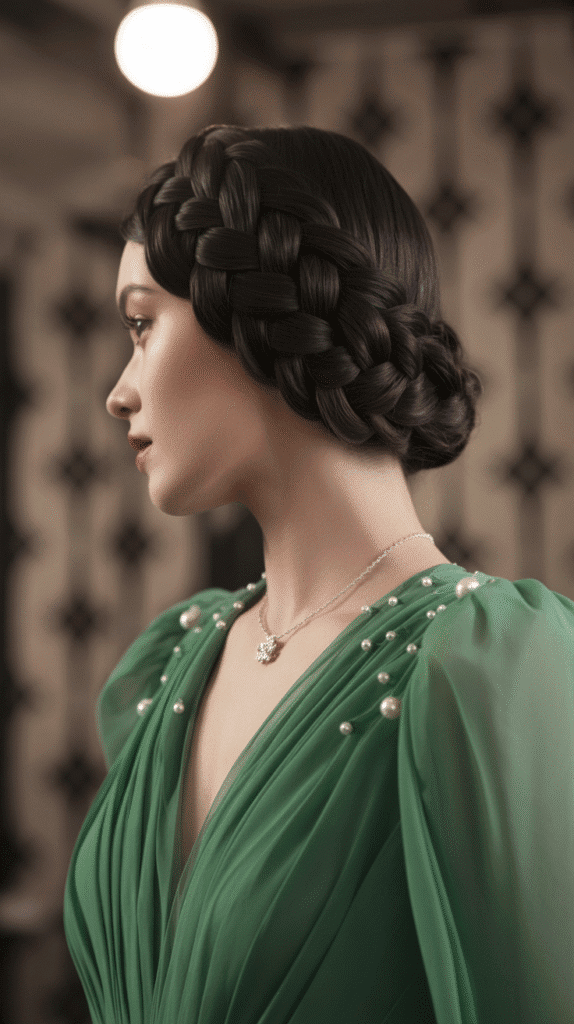
Braided updos combined the practicality of keeping hair secured with the decorative beauty of intricate braid patterns, creating elaborate styles perfect for evening events and special occasions throughout the 1930s.
These styles showcased skill and patience in hairstyling while maintaining the era’s romantic aesthetic.
Construction Elements:
- Multiple braids incorporated into a single updo
- Braids arranged in patterns, swirls, or geometric designs
- Pinned securely to create a lasting style
- Sometimes combined with twisted sections
- Could incorporate hairpieces for additional fullness
Popular Patterns:
- Crown of braids encircling the head
- Braids coiled at the nape in a low bun
- Crisscross patterns across the back of the head
- Braided sections woven through finger waves
- Asymmetrical designs with braids on one side only
16. Soft Feathered Ends
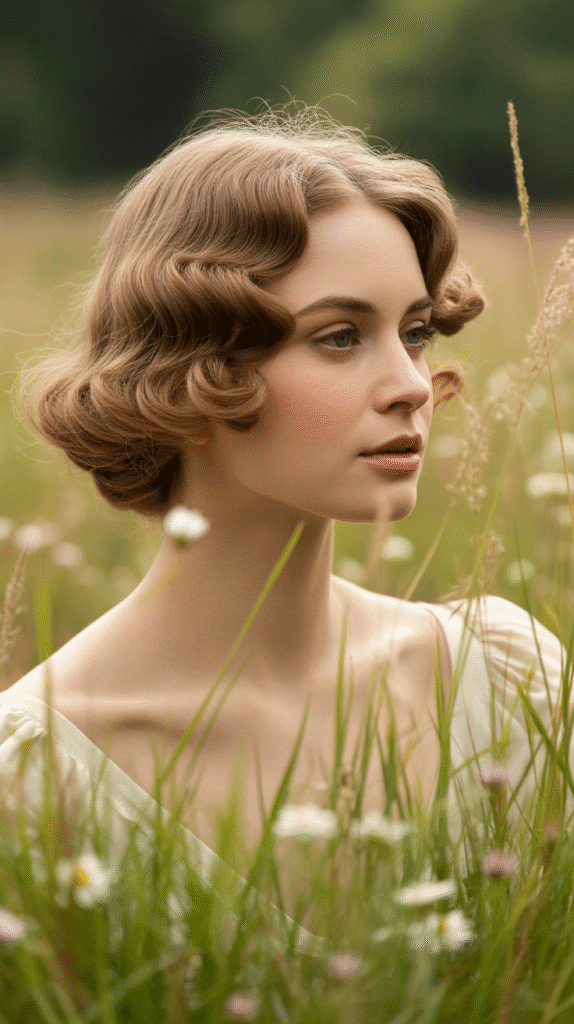
Soft feathered ends became popular in the mid-to-late 1930s as women sought to soften the structured looks of earlier in the decade.
This technique involved tapering the hair ends to create a wispy, feathered effect that moved naturally and caught light beautifully.
Cutting Technique:
- Hairdressers used razors to thin hair ends
- Created gradual, soft graduation rather than blunt lines
- Removed weight from ends for enhanced movement
- Hair appeared lighter and more ethereal
- Worked best on medium to long lengths
Styling Benefits:
- Ends curved and waved more easily
- Hair appeared to have more natural movement
- Less severe than blunt-cut styles
- Created a softer, more romantic silhouette
- Required less rigid setting patterns
17. Sculptured Crown
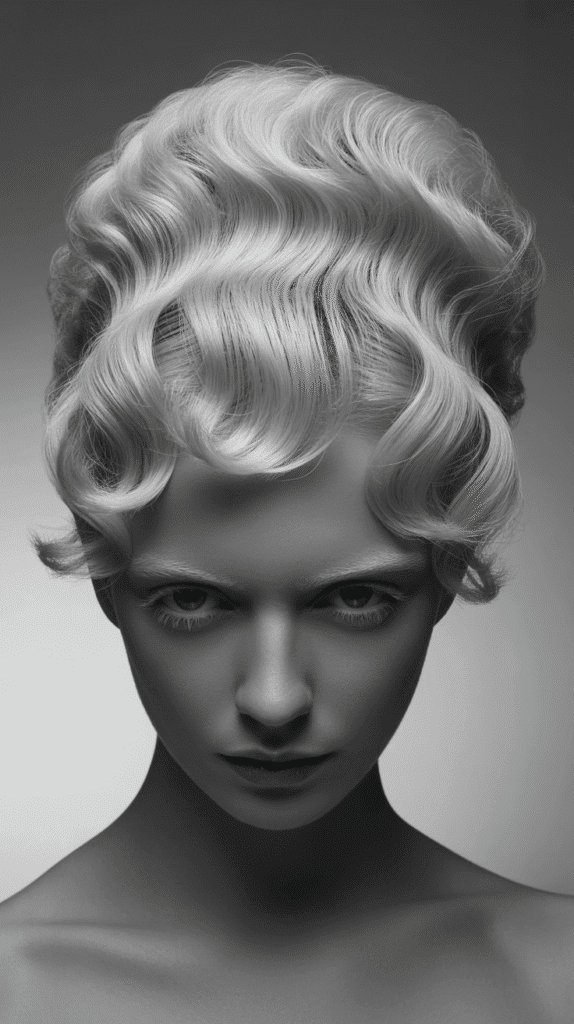
The sculptured crown focused attention on the top of the head through elaborate arrangements of waves, curls, and rolls that created dimension and architectural interest.
This styling approach elevated simple wave patterns into artistic statements that showcased hairdressing skill.
Design Approach:
- Crown area was treated as the focal point
- Multiple wave patterns converged at the highest point
- Pin curls arranged in circular or radiating patterns
- Height was built through backcombing and strategic pinning
- Sides and back were styled more simply to emphasize the crown
Artistic Elements:
- Waves flowed in deliberate directions to create movement
- Light and shadow enhanced the dimensional quality
- Could be symmetrical or asymmetrically balanced
- Incorporated ridges, peaks, and valleys in the design
- Required significant setting time and skill
18. The Joan Crawford Wave
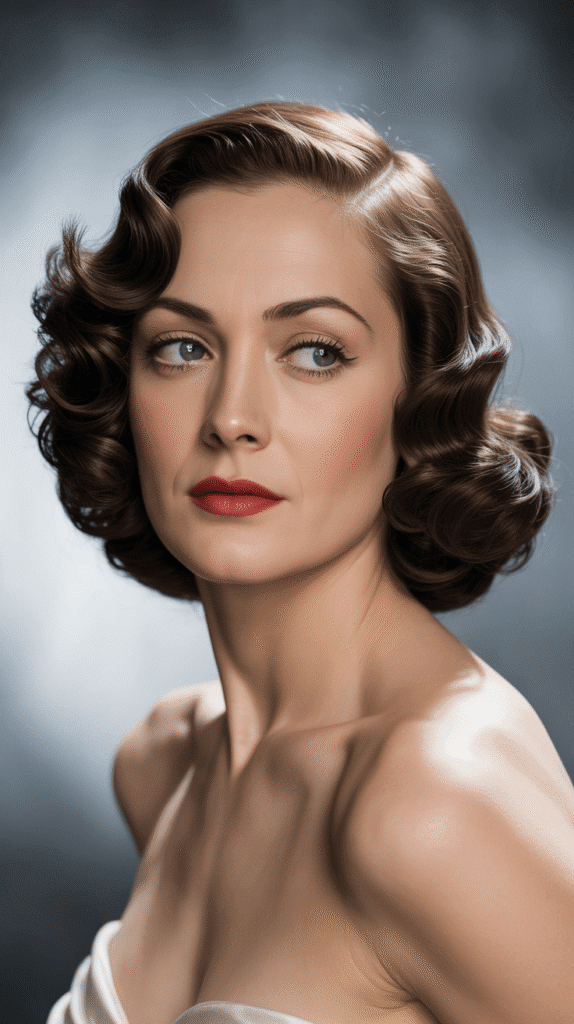
Joan Crawford’s powerful screen presence was matched by her dramatic hairstyles that featured wide, deeply curved waves with substantial height and volume.
Her look epitomized Hollywood glamour and inspired women to embrace bolder, more structured styling.
Defining Characteristics:
- Wide wave patterns (3-4 inches between ridges)
- Significant height at the crown and temples
- Structured, almost geometric precision
- Often featured a dramatic side part
- Maintained perfect symmetry and balance
Crawford’s Evolution:
- Early 1930s featured tighter, more compact waves
- Mid-decade saw wider, more dramatic patterns
- Later years incorporated softer, more relaxed styling
- Consistently maintained dark hair color
- Always emphasized strong eyebrows to balance the hair
19. Rolled Sides
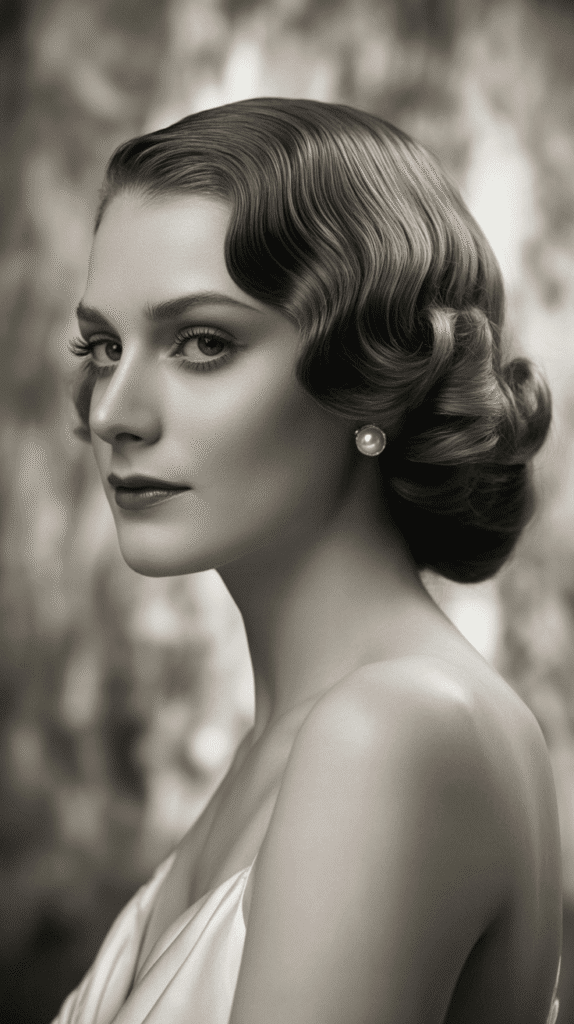
Rolled sides featured the side sections of hair smoothly rolled upward and backward, creating a lifted, elegant frame for the face while keeping hair away from the cheeks and temples.
This versatile element could be incorporated into various hairstyles throughout the 1930s.
Rolling Technique:
- Side sections were divided from crown to behind ears
- Hair was brushed smooth and rolled toward the back
- Rolls were pinned securely with bobby pins
- Could be tight and compact or loose and soft
- Both sides could match or create asymmetry
Styling Flexibility:
- Combined with updos, chignons, or loose curls
- Worked with short, medium, or long hair
- Created a neat, groomed appearance
- Revealed earrings and face shape
- Could be high on the head or low near the neckline
20. The Shirley Temple Curl
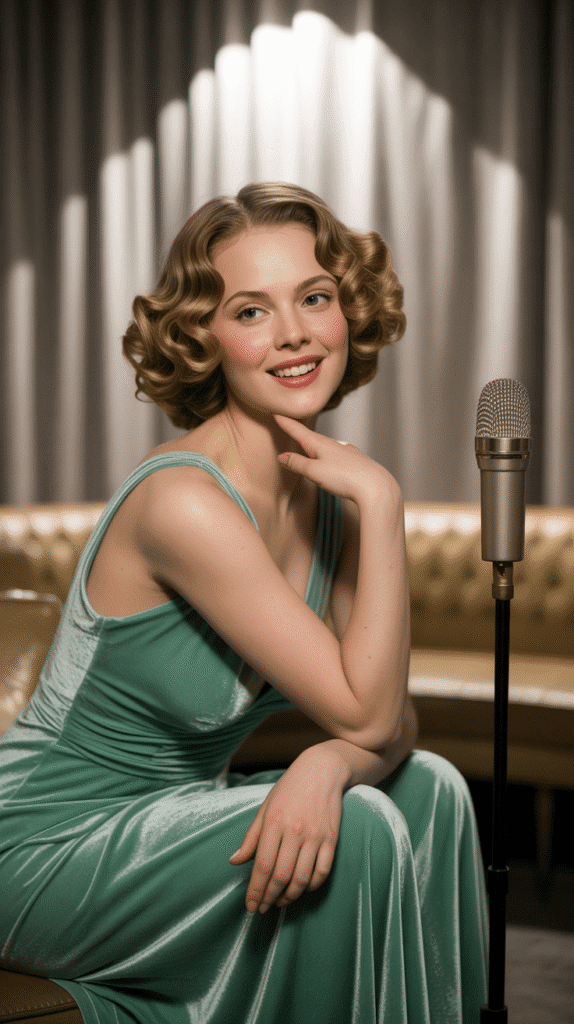
While Shirley Temple was a child star, her signature ringlet curls influenced women’s hairstyling in the late 1930s, with adult interpretations featuring defined spiral curls that conveyed youth, vitality, and optimism during difficult economic times.
Adult versions were more sophisticated but maintained the bouncy, cheerful quality.
Adult Adaptation:
- Used larger curling rods than children’s versions
- Curls were more spaced out and less uniform
- Combined with more mature styling elements
- Applied primarily to longer hair lengths
- Created romantic, feminine appeal
Setting Method:
- Hair was wrapped around vertical rods or rolled in spiral pin curls
- Each section was set from ends to roots in a corkscrew pattern
- Curls dried completely before being separated gently
- Light pomade added definition without weight
- Could be brushed partially for softer effect
21. Center Part with Waves
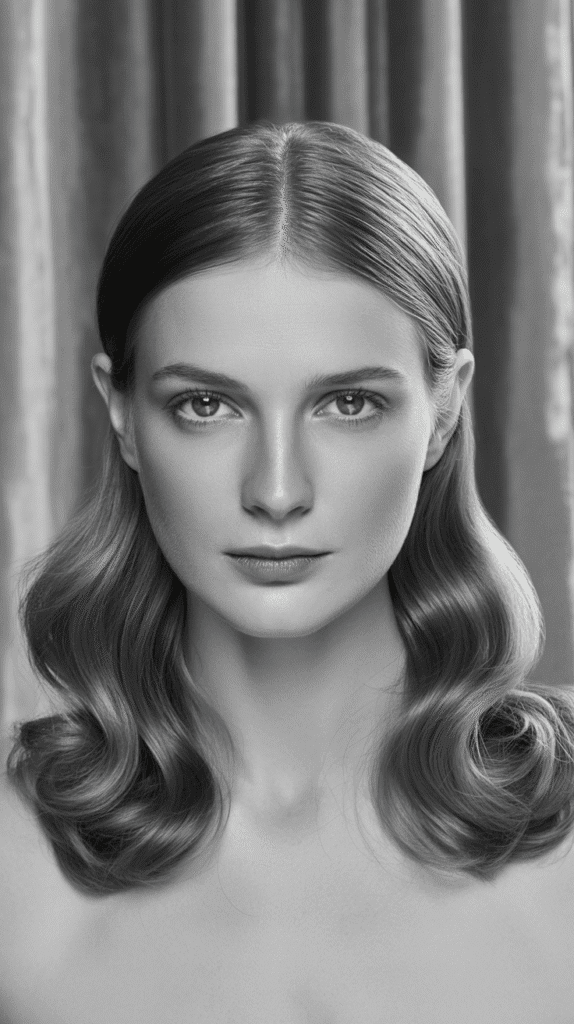
The center part with waves offered a balanced, symmetrical approach to 1930s hairstyling that suited many face shapes and created a classic, timeless appearance.
This style emphasized harmony and proportion through evenly distributed waves flowing from a precise center division.
Style Components:
- Perfectly straight center part from forehead to crown
- Mirror-image waves on each side
- Waves could be finger waves, marcel waves, or soft pin curls
- Length varied from short bobs to shoulder-length
- Emphasized facial symmetry
Achieving Balance:
- Part was measured carefully for exact centering
- Wave patterns matched in size and placement
- Pin curls set in identical directions on each side
- Same number of waves on both sides
- Smooth, polished finish throughout
22. Faux Bob with Pinned Hair
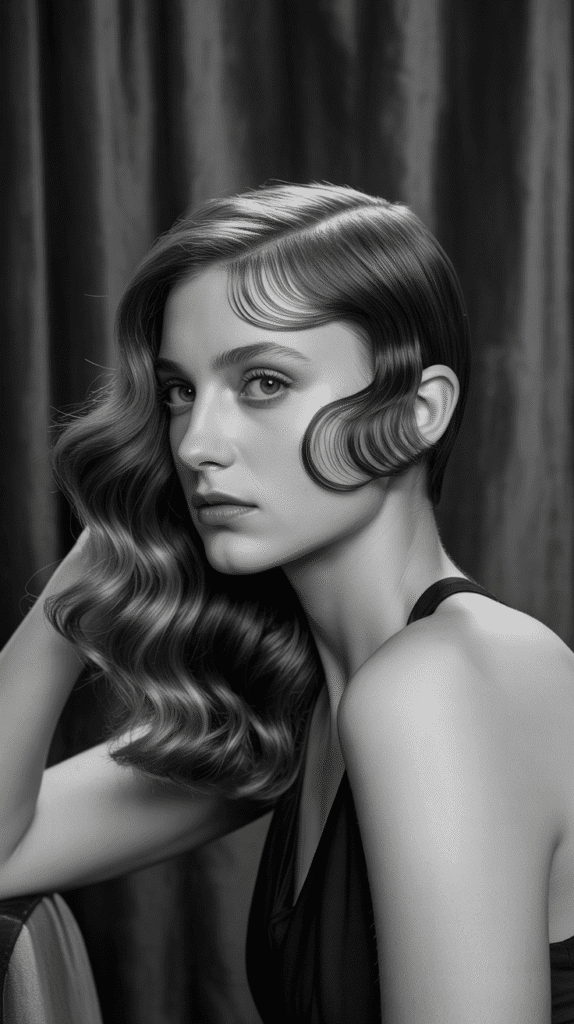
The faux bob allowed women with longer hair to achieve the fashionable short bob appearance without cutting their hair, providing versatility for those who wanted options.
This clever technique involved pinning longer hair under to create the illusion of shorter length.
Creating the Illusion:
- Hair was set in pin curls throughout
- After drying, hair was brushed smooth
- Lengths were folded under and pinned at the nape
- The visible portion appeared to be a bob
- Could be easily undone for longer styling
Strategic Advantages:
- Allowed experimentation without commitment
- Provided multiple looks from one length
- Suitable for women growing out shorter cuts
- Easier to maintain than constant cutting
- Could transition from day to evening by unpinning
23. Asymmetrical Wave Pattern
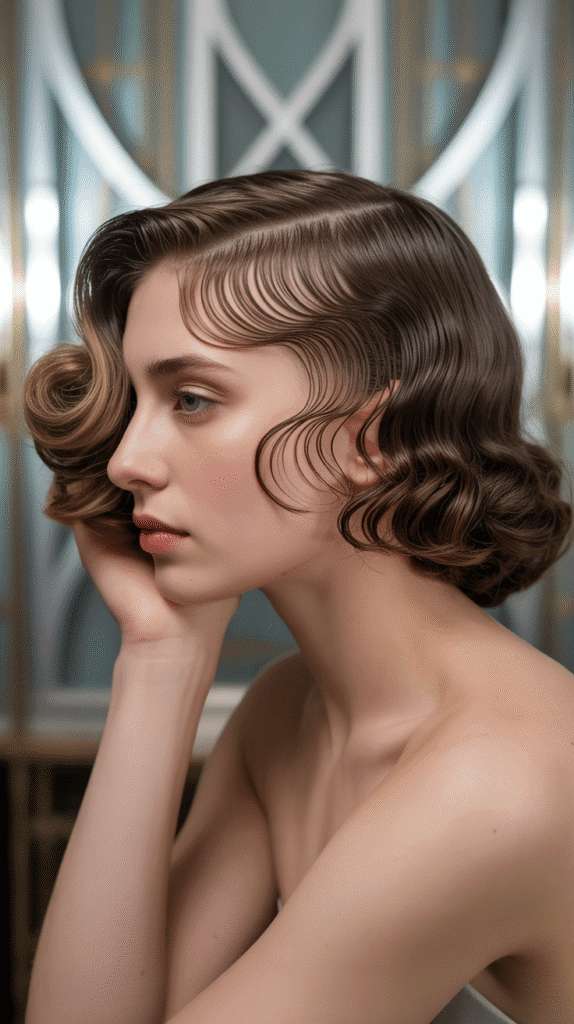
Asymmetrical wave patterns broke from traditional symmetry to create dynamic, artistic hairstyles that drew the eye and showcased creativity.
These styles featured intentionally different wave patterns, sizes, or directions on each side of the head.
Design Strategy:
- One side featured larger, wider waves
- The opposite side had tighter, more numerous waves
- Created visual interest through contrast
- Required careful planning before setting
- Often combined with asymmetrical parts
Artistic Considerations:
- Larger waves typically placed on the side with more hair
- Tighter waves on the side with less hair
- Could emphasize preferred profile angle
- Balanced by keeping one element symmetrical
- Showcased hairdresser’s technical skill
24. The Coronet Braid
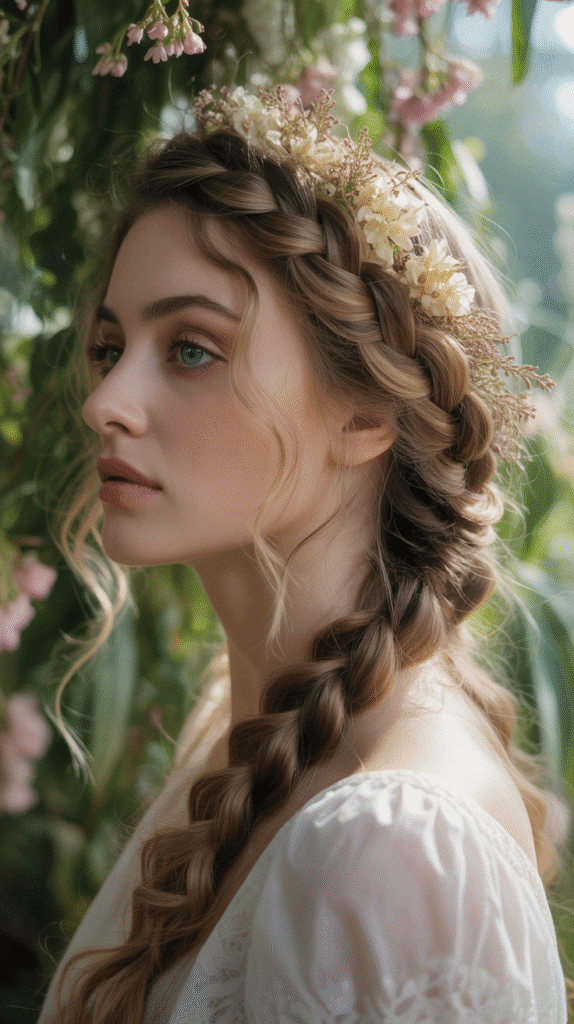
The coronet braid created a regal, sophisticated appearance by wrapping braided hair around the head like a crown, keeping all hair secured while maintaining a feminine, romantic aesthetic.
This style was particularly popular for daytime activities and informal evening gatherings.
Construction Process:
- Hair was divided into sections for braiding
- One or more braids were created
- Braids were wrapped around the head circularly
- Pinned securely at intervals
- Ends were tucked under and hidden
Styling Variations:
- Single thick braid forming the coronet
- Multiple thinner braids woven together
- Braids starting at the nape and wrapping forward
- Braids beginning at the temples and meeting at back
- Combined with fresh flowers or decorative pins
25. Deep Waves with Height
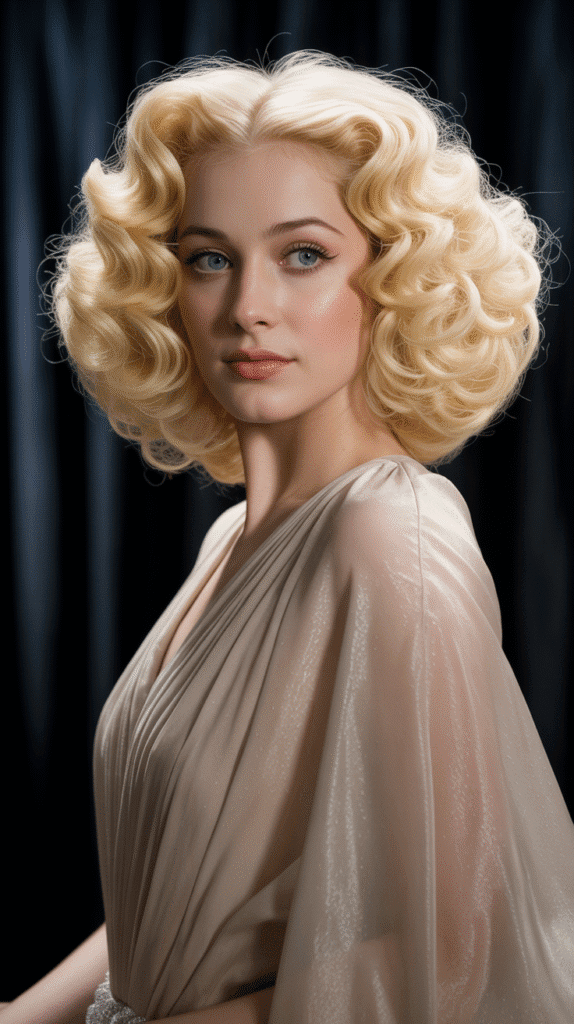
Deep waves with height combined the era’s love of wave patterns with dramatic vertical dimension, creating imposing, glamorous styles that commanded attention.
This approach built significant volume at the crown while maintaining defined wave patterns throughout.
Building Technique:
- Crown section was extensively backcombed
- Front sections were rolled back over the base
- Waves were set on large rollers for depth
- Multiple layers of waves created dimension
- Strong-hold products maintained lift
Structural Elements:
- Height ranged from 2-5 inches above natural hairline
- Waves flowed backward and downward from the peak
- Side sections incorporated into the elevated area
- Back hair could hang in curls or waves
- Required frequent touch-ups throughout the day
26. Soft Romantic Curls
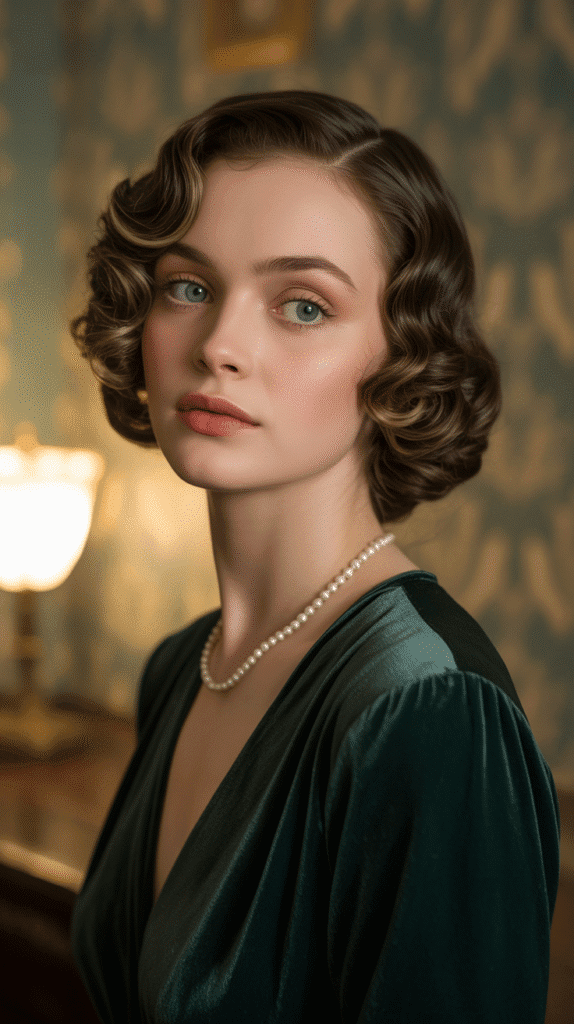
Soft romantic curls offered a gentler alternative to structured waves, featuring loosely defined curls that cascaded naturally and created an ethereal, feminine appearance.
This style became increasingly popular in the late 1930s as fashions shifted toward softer, more flowing silhouettes.
Achieving Softness:
- Hair was set in large pin curls or rollers
- Curls were barely brushed after drying
- Definition was kept loose and natural
- Products were minimal to maintain movement
- Curls varied in size for organic appearance
Romantic Qualities:
- Created gentle movement with each head turn
- Caught and reflected light beautifully
- Appeared effortless despite setting time
- Worked well with flowers or decorative combs
- Suited garden parties and afternoon teas
27. The Working Woman’s Wave
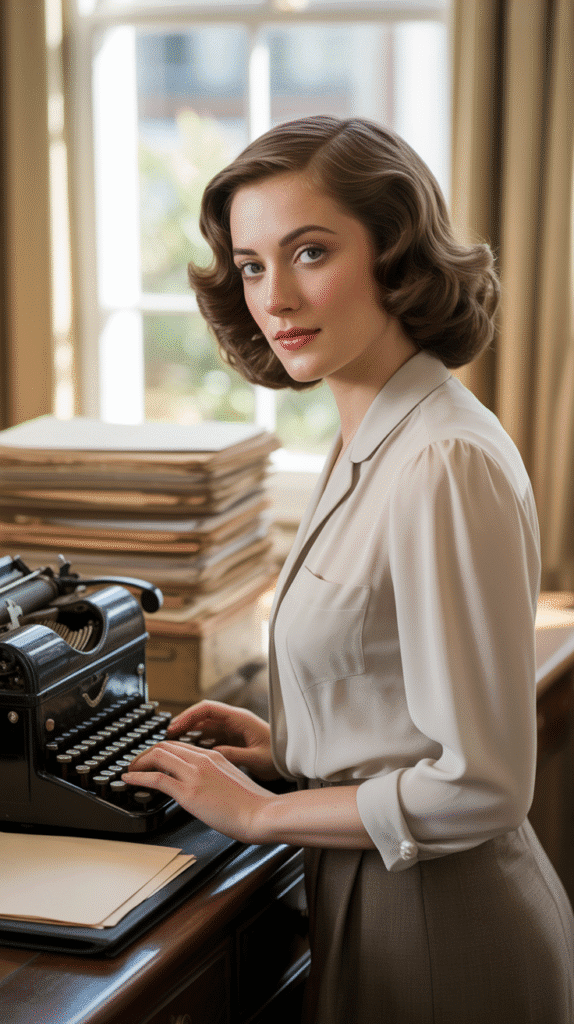
The working woman’s wave represented practical elegance for the growing number of women entering the workforce during the 1930s, combining professional appearance with manageable styling that could withstand a full day’s activities.
This style balanced neatness with femininity without requiring constant maintenance.
Practical Design:
- Moderate wave pattern that held throughout the day
- Shorter length for convenience (chin to shoulder)
- Pinned sections to keep hair off face
- Conservative styling appropriate for offices
- Could be refreshed quickly during lunch breaks
Workplace Suitability:
- Neat appearance from morning to evening
- Didn’t interfere with clerical work or typing
- Complemented tailored suits and blouses
- Required simple morning styling routine
- Represented professionalism and competence
Social Context:
According to the U.S. Bureau of Labor Statistics historical data, women’s workforce participation increased during the 1930s despite the Depression, necessitating hairstyles that balanced femininity with professional practicality, leading to simplified versions of elaborate Hollywood styles.
Styling Tips for Modern Adaptation
Bringing 1930s hairstyles into contemporary styling requires understanding both historical techniques and modern hair care products. Today’s adaptations can honor the vintage aesthetic while incorporating current hair health knowledge and easier styling methods.
Modern Products for Vintage Styles:
- Use heat protectant sprays before applying hot tools
- Substitute setting lotion with flexible-hold mousse
- Replace heavy pomades with lightweight shine serums
- Employ texturizing sprays for added grip when creating pin curls
Technique Modifications:
- Flat irons can create sleek sections before wave formation
- Modern curling wands replace heated marcel irons safely
- Velcro rollers offer quick setting without pins for some styles
- Blow dryers with diffusers speed up the drying process
- Temporary hair color sprays allow platinum experiments without bleach damage
Contemporary Occasions:
- Vintage weddings and themed celebrations
- Gatsby or period costume parties
- Retro photo shoots and pin-up sessions
- Red carpet events seeking Old Hollywood glamour
- Everyday styling for vintage fashion enthusiasts
Hair Health Considerations:
Modern understanding of hair care means adapting 1930s techniques to avoid the damage that era’s harsh chemicals and excessive heat caused; deep conditioning treatments should follow any heat styling, regular trims maintain healthy ends for curl formation, and protein treatments strengthen hair subjected to frequent manipulation and setting.
Historical Context and Cultural Impact
The 1930s hairstyles emerged from a unique intersection of technological advancement, economic hardship, and Hollywood’s golden age. Understanding this context enriches appreciation for these enduring styles and their continued relevance.
Depression Era Influences:
- Home styling became essential as salon visits were luxury expenses
- Women learned complex techniques from magazines and each other
- Hairstyles needed to last multiple days without restyling
- Simple elegance replaced the extravagance of the 1920s
- Practicality merged with the desire to maintain feminine beauty
Hollywood’s Role:
The movie industry wielded unprecedented influence over beauty standards during this decade, with actresses like Jean Harlow, Greta Garbo, Joan Crawford, Marlene Dietrich, and Katharine Hepburn becoming style icons whose every appearance was scrutinized and imitated by millions of women worldwide seeking glamour during difficult times.
Technological Advances:
- Electric curling irons became more widely available
- Improved hair setting products extended style longevity
- Home permanent wave kits appeared in drugstores
- Beauty magazines increased circulation with detailed tutorials
- Photography improvements allowed better documentation of styles
Social Shifts:
According to fashion historians, the 1930s marked a transition period where women’s hairstyles reflected changing social roles, moving from the rebellious short cuts of the 1920s to softer, more traditionally feminine styles that nevertheless maintained the independence women had gained, creating a visual balance between modernity and femininity.
Tools and Products of the Era
Understanding the tools and products that created 1930s hairstyles provides insight into both the dedication required and the innovations that made these looks possible for everyday women.
Period Products:
- Wave set lotions containing gums and resins for hold
- Brilliantine or pomade for shine and smoothness
- Henna and chamomile for natural hair coloring
- Peroxide solutions for lightening (often dangerously strong)
- Vinegar rinses for removing product buildup and adding shine
Setting Techniques:
Women typically washed hair once weekly due to the time-intensive setting process; hair was set wet using pin curls, rollers, or finger waves; styles were protected during sleep with hair nets or silk scarves; touch-ups between washings involved dampening sections and re-curling; dry shampoos (talcum powder) absorbed oils between washings.
Face Shape Considerations
The 1930s emphasized selecting hairstyles that complemented individual face shapes, a principle that remains valuable today.
Different styles from this era naturally suited various facial structures.
Oval Faces:
- Could wear virtually any 1930s style successfully
- Looked elegant in center-parted waves
- Suited both updos and flowing curls
- Marcel waves and finger waves were particularly flattering
- Asymmetrical styles added interest without overwhelming
Round Faces:
- Benefited from height at the crown (pompadour, deep waves with height)
- Side parts created diagonal lines for slimming effect
- Vertical emphasis with victory rolls elongated the face
- Avoid styles that added width at cheekbones
- Longer lengths with side-swept waves provided balance
Square Faces:
- Soft romantic curls gentled angular jawlines
- Side-swept waves created asymmetry softening geometric features
- Avoid blunt, chin-length bobs that emphasized jaw width
- Feathered ends and gentle waves added femininity
- Styles with movement at temples softened strong features
Heart-Shaped Faces:
- Wider wave patterns at jaw level balanced narrow chins
- Pageboy cuts with fullness at ends were ideal
- Avoid excessive height that overemphasized wide foreheads
- Side parts directed attention away from forehead width
- Chin-length curls created perfect proportion
Long Faces:
- Horizontal wave patterns created width perception
- Avoided excessive height that elongated further
- Side-swept styles with volume added balance
- Shorter lengths (chin to shoulder) were most flattering
- Bangs or fringe shortened visual face length
Celebrity Style Icons
The 1930s produced numerous style icons whose hairstyles defined the decade and continue to inspire contemporary fashion.
Each brought distinctive qualities to their signature looks.
Jean Harlow (1911-1937):
- Pioneered platinum blonde as a beauty standard
- Trademark soft waves with ultimate shine
- Tragically died young, cementing her iconic status
- Represented Hollywood glamour and sex appeal
- Her look required constant maintenance and professional care
Greta Garbo (1905-1990):
- Embodied sophisticated, understated elegance
- Favored sleek bobs and controlled waves
- Natural coloring rather than platinum trends
- European sensibility influenced American tastes
- Mystery and aloofness enhanced her appeal
Joan Crawford (1904-1977):
- Known for dramatic, structured wave patterns
- Strong, geometric styling matched powerful screen presence
- Wide, defined waves became her signature
- Evolved her look throughout the decade
- Represented ambition and determination
Marlene Dietrich (1901-1992):
- Brought continental sophistication to Hollywood
- Sleek, androgynous styling challenged norms
- Perfectly controlled waves with high gloss
- Influenced both fashion and hair internationally
- Maintained consistent look across decades
Katharine Hepburn (1907-2003):
- Offered alternative to typical glamour styles
- More natural, less constructed approach
- Athletic, independent persona reflected in hair
- Preferred practical styles over elaborate waves
- Represented modern American womanhood
Adaptation for Different Hair Types
The original 1930s hairstyles were primarily designed for fine to medium, straight or slightly wavy Caucasian hair textures, but modern adaptations can honor the aesthetic across all hair types with appropriate modifications.
Fine, Straight Hair:
- Holds finger waves and marcel waves exceptionally well
- Requires volumizing products for height and body
- Pin curls create lasting wave patterns
- Teasing and backcombing provide necessary fullness
- Setting lotion essential for pattern retention
Thick, Coarse Hair:
- Benefits from thinning at ends for easier curl formation
- Requires stronger products for hold
- More difficult to achieve tight finger waves
- Holds larger wave patterns and victory rolls beautifully
- May need professional expertise for intricate styles
Naturally Curly or Wavy Hair:
- Can be straightened first for authentic wave control
- Or embraced and styled into adapted romantic curls
- Pin curls redirect natural curl patterns
- Requires anti-frizz products for smooth finish
- Offers natural volume for height-focused styles
Textured and Coily Hair:
- Silk press or blow-out creates smooth base for wave patterns
- Protective styling principles should guide adaptations
- Modern techniques preserve hair health while achieving looks
- Wigs and hairpieces offer damage-free vintage styling
- Creative adaptations honor both heritage and aesthetic
Modern Inclusivity:
Contemporary vintage enthusiasts recognize that 1930s Hollywood excluded many textures and ethnicities from representation, but today’s styling community celebrates adapting these aesthetics across all hair types, using modern products and techniques that prioritize hair health while achieving desired vintage appearances, creating inclusive vintage communities that honor history while correcting its limitations.
Maintenance and Longevity
Achieving 1930s hairstyles required significant time investment, and maintaining them throughout the week demanded specific care routines that modern enthusiasts should understand.
Weekly Washing Routine:
- Hair washed typically once per week on designated day
- Setting process began immediately after washing
- Entire day often devoted to hair preparation
- Multiple hours required for setting, drying, and styling
- Styles needed to last until next wash day
Nightly Protection:
- Hair wrapped in silk or satin scarves
- Pin curls refreshed in sections showing wear
- Hair nets prevented disruption during sleep
- Some styles required sleeping sitting up or on special pillows
- Morning touch-ups addressed overnight flattening
Between-Wash Maintenance:
- Dry shampoo (talcum powder) absorbed scalp oils
- Damp finger waves refreshed with water and re-setting
- Loose curls re-pinned at night
- Shine products applied to combat dullness
- Broken waves repaired with heated irons
Product Buildup:
The heavy products used in the 1930s created significant buildup; vinegar or lemon juice rinses helped clarify hair; baking soda occasionally substituted for shampoo; excessive buildup required extra washing despite inconvenience; modern clarifying shampoos offer easier solutions for contemporary adaptations.
Common Styling Mistakes to Avoid
Even experienced stylists can encounter challenges when creating 1930s hairstyles. Understanding common pitfalls helps achieve more authentic and polished results.
Technical Errors:
- Using insufficient product resulting in waves that fall flat
- Applying too much product creating stiff, unnatural appearance
- Incomplete drying causing waves to drop immediately
- Incorrect pin curl direction creating chaotic rather than smooth waves
- Brushing too aggressively destroying carefully set patterns
Aesthetic Mistakes:
- Mixing styles from different decades creating confused look
- Adding modern elements that break vintage illusion
- Excessive teasing creating 1960s volume inappropriate for 1930s
- Wrong makeup choices undermining hair authenticity
- Inappropriate accessories from wrong time periods
Hair Health Issues:
- Excessive heat damage from unprotected hot tool use
- Over-processing from chemical straightening or coloring
- Breakage from tight pinning or aggressive brushing
- Dryness from alcohol-heavy styling products
- Damage from sleeping in bobby pins nightly
Proportion Problems:
- Wave patterns too small or too large for face size
- Excessive height overwhelming petite frames
- Insufficient volume on larger frames
- Asymmetry that unbalances rather than flatters
- Styles inappropriate for hair length or density
Photography and Presentation
The 1930s hairstyles were designed with photography in mind, as Hollywood portraits and fashion magazines were primary vehicles for disseminating beauty standards.
Understanding this relationship enhances modern recreations.
Lighting Considerations:
- Styles were designed to create shadows and highlights
- Wave patterns became more dramatic under directional lighting
- High shine was essential for photographic definition
- Black and white photography emphasized contrast
- Front lighting flattened features, side lighting enhanced dimension
Angles and Poses:
- Three-quarter views showcased wave patterns best
- Profile shots displayed side-swept styles beautifully
- Overhead lighting emphasized crown height and volume
- Tilted head positions created romantic effects
- Hand placement near face drew attention to hairstyle
Modern Photography Tips:
- Use continuous lighting rather than flash for vintage effect
- Slightly overexpose for softer, classic appearance
- Black and white conversion enhances authenticity
- Shoot in locations with art deco or period-appropriate settings
- Consider clothing and makeup as integral to overall presentation
Conclusion
The enduring appeal of 27 Iconic 1930s Hairstyles for Women That Stay Forever Stylish lies in their perfect balance of elegance, femininity, and artistic expression that transcends the boundaries of time and trend.
These hairstyles emerged from a decade marked by economic hardship yet produced some of the most glamorous and meticulously crafted beauty looks in history, proving that creativity and grace flourish even in challenging circumstances.
From Jean Harlow’s platinum waves that shocked and captivated audiences to Greta Garbo’s understated sophistication, from the architectural precision of finger waves to the romantic softness of feathered curls, each style tells a story of women who refused to surrender beauty and self-expression during difficult times.
Modern enthusiasts who recreate these looks connect with a rich legacy of Hollywood glamour, technical artistry, and the timeless pursuit of elegance that defined the golden age of cinema.
Whether you choose to embrace these styles for special occasions, vintage events, or everyday glamour, you’re participating in a beauty tradition that has inspired generations and will continue to captivate for decades to come.
The techniques, dedication, and artistry behind these 27 iconic hairstyles remind us that true style is never confined to a single era but instead evolves, adapts, and returns to inspire new generations who recognize that elegance, like these waves and curls, moves in beautiful, eternal patterns.